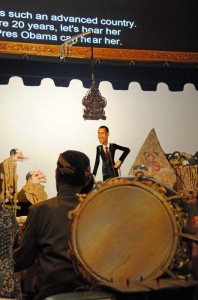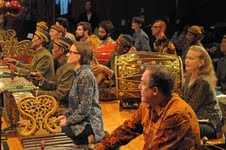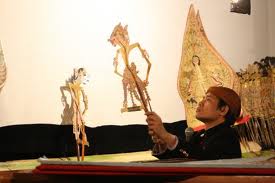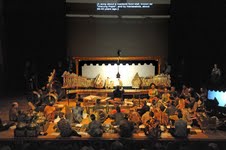President Obama made a surprise cameo appearance at the Asia Society’s production of a Javanese shadow puppet show  — a Wayang Kulit — by dhalang Ki Purbo Asmoro with Gamelan Kusuma Laras on Manhattan’s upper east side on Friday night (March 16).
As a translucent strip of water buffalo hide, upright if not as nimble on his tusk-bone rods as flesh-and-blood Obama is on the campaign trail,  the puppet Obama popped up among a trio of clownish Javanese street-types. At first they addressed him with awe, one bowing to kiss the President’s ring. But then he turned assertive, urging — admonishing! — President O to spend US money on arts and education, not on war.
The puppet president said he would. Gongs struck and bells rang, a deep bass drum thumped, women sang in the highest range of human pitch, a haze of whistles, wavery flutes, bowed strings sounds or maybe just overtones arose over the gaggle of musicians sitting crosslegged at bottoms-up brass kettles lodged firmly in low, carved wood frames. The musicians hammered short, repeating note patterns on the xylophone-like metal slats, banged on slender barrel drums and struck cymbals.
The audience would have become raucous if we’d been at one of Java’s traditional seven-hour wayang kulit extravaganzas, outdoors family overnight picnics held in fields, fairgrounds, village squares, parks, schools, really anywhere. But then we’d have been sitting on the far side of a screen to watch the puppets’ shadows, rather than in theater seats at the elegant Asia Society edifice on Park Avenue. We wouldn’t have watched the shadow-side of the show on a big tv screen at the lip of the  stage.
No simultaneous English translation would have been projected above the puppet stage of the dhalang’s multi-voiced characterizations depicting Bima’s Spiritual Enlightenment and quest-search from forest floor to the ocean depths. There’d have been no live webcast of the event (I assume it will be archived eventually at AsiaSociety.org/live). We’d have been in Java or Bali.
Indonesian wayang kulits and performances by gamelan orchestras aren’t frequent in NYC, and though this one was spectacular, it required a stretch of the imagination and suspension of residents’ inherent impatience to enjoy. Obama showing up during a comic interlude spelling relief from the Bima plot lent the evening its liveliest moments.
A dhalang, the puppet master, is supposed to be adept at improvising such bits of social commentary as well as philosophical speculation and dramatic variations; dhalang Purbo Asmoro is, according to Asia Society’s program notes, “at the forefront of the modern, classical interpretive treatment” of wayang. Reportedly he both embodies the 900-year-old traditions of the form, which has been recognized by UNESCO as a “masterpiece of human heritage,” and also adopts contemporary innovations, while standing above recent trends to trivialize the art or render it unfamiliarly avant-garde.
However, the story drawn from the Hindu epic Mahabharata is neither familiar to most Westerners nor compelling to audiences conditioned to fast-paced editing and computer generated imagery. Bahasa Indonesia is incomprehensible to most Americans so Asmoro’s inflections, asides and word-play were lost on us (Kathryn (Kitsie) Emerson is amazing at the simultaneous translation, howver, keying it into the computer as quick as Asmoro spoke) . The tale’s humor and puppets’ knockabout tiffs seemed roughly as sophisticated as a Three Stooges routine. Time didn’t have our accustomed pace.
Yet the shadow theater and gamelan experience is worthwhile precisely for taking us from our usual entertainments. For a while I sat in a front row, two yards at most from the orchestra, and became immersed in the shimmering net of sonic ribbons and knots, dynamic intensities and relaxations created almost exclusively by the synchronized percussion. Â If I didn’t understand the puppet master’s nuances, I could admire his handwork, commanding stick figures to bob and weave, strike poses of pride and humility. I wasn’t on the edge of my seat concentrating on psychological realism, but no one suggested that I should be.
With audience members coming and going, people of all ages walking up onstage to view the puppets as they’re viewed in Java and Bali, shadows on a screen, a welcomed informality reigned.
The Asia Society provided food and drink and places to sit and chat outside the theater, in emulation of the festive, neighborly atmosphere wayang kulits create at home. In shadow puppet and gamelan shows, there is apparently no fourth wall.




